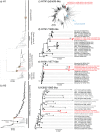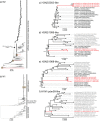Divergent Human-Origin Influenza Viruses Detected in Australian Swine Populations
- PMID: 29875251
- PMCID: PMC6069171
- DOI: 10.1128/JVI.00316-18
Divergent Human-Origin Influenza Viruses Detected in Australian Swine Populations
Abstract
Global swine populations infected with influenza A viruses pose a persistent pandemic risk. With the exception of a few countries, our understanding of the genetic diversity of swine influenza viruses is limited, hampering control measures and pandemic risk assessment. Here we report the genomic characteristics and evolutionary history of influenza A viruses isolated in Australia from 2012 to 2016 from two geographically isolated swine populations in the states of Queensland and Western Australia. Phylogenetic analysis with an expansive human and swine influenza virus data set comprising >40,000 sequences sampled globally revealed evidence of the pervasive introduction and long-term establishment of gene segments derived from several human influenza viruses of past seasons, including the H1N1/1977, H1N1/1995, H3N2/1968, and H3N2/2003, and the H1N1 2009 pandemic (H1N1pdm09) influenza A viruses, and a genotype that contained gene segments derived from the past three pandemics (1968, reemerged 1977, and 2009). Of the six human-derived gene lineages, only one, comprising two viruses isolated in Queensland during 2012, was closely related to swine viruses detected from other regions, indicating a previously undetected circulation of Australian swine lineages for approximately 3 to 44 years. Although the date of introduction of these lineages into Australian swine populations could not be accurately ascertained, we found evidence of sustained transmission of two lineages in swine from 2012 to 2016. The continued detection of human-origin influenza virus lineages in swine over several decades with little or unpredictable antigenic drift indicates that isolated swine populations can act as antigenic archives of human influenza viruses, raising the risk of reemergence in humans when sufficient susceptible populations arise.IMPORTANCE We describe the evolutionary origins and antigenic properties of influenza A viruses isolated from two separate Australian swine populations from 2012 to 2016, showing that these viruses are distinct from each other and from those isolated from swine globally. Whole-genome sequencing of virus isolates revealed a high genotypic diversity that had been generated exclusively through the introduction and establishment of human influenza viruses that circulated in past seasons. We detected six reassortants with gene segments derived from human H1N1/H1N1pdm09 and various human H3N2 viruses that circulated during various periods since 1968. We also found that these swine viruses were not related to swine viruses collected elsewhere, indicating independent circulation. The detection of unique lineages and genotypes in Australia suggests that isolated swine populations that are sufficiently large can sustain influenza virus for extensive periods; we show direct evidence of a sustained transmission for at least 4 years between 2012 and 2016.
Keywords: antigenicity; influenza surveillance; pandemic risk; phylogenetic analysis; reassortment; swine influenza.
Copyright © 2018 American Society for Microbiology.
Figures




Similar articles
-
Characterization of co-circulating swine influenza A viruses in North America and the identification of a novel H1 genetic clade with antigenic significance.Virus Res. 2015 Apr 2;201:24-31. doi: 10.1016/j.virusres.2015.02.009. Epub 2015 Feb 18. Virus Res. 2015. PMID: 25701742
-
Molecular Epidemiology and Evolution of Influenza Viruses Circulating within European Swine between 2009 and 2013.J Virol. 2015 Oct;89(19):9920-31. doi: 10.1128/JVI.00840-15. Epub 2015 Jul 22. J Virol. 2015. PMID: 26202246 Free PMC article.
-
Reassortment between Swine H3N2 and 2009 Pandemic H1N1 in the United States Resulted in Influenza A Viruses with Diverse Genetic Constellations with Variable Virulence in Pigs.J Virol. 2017 Jan 31;91(4):e01763-16. doi: 10.1128/JVI.01763-16. Print 2017 Feb 15. J Virol. 2017. PMID: 27928015 Free PMC article.
-
[Swine influenza virus: evolution mechanism and epidemic characterization--a review].Wei Sheng Wu Xue Bao. 2009 Sep;49(9):1138-45. Wei Sheng Wu Xue Bao. 2009. PMID: 20030049 Review. Chinese.
-
Swine influenza viruses: an Asian perspective.Curr Top Microbiol Immunol. 2013;370:147-72. doi: 10.1007/82_2011_195. Curr Top Microbiol Immunol. 2013. PMID: 22266639 Review.
Cited by
-
When Pigs Fly: Pandemic influenza enters the 21st century.PLoS Pathog. 2020 Mar 19;16(3):e1008259. doi: 10.1371/journal.ppat.1008259. eCollection 2020 Mar. PLoS Pathog. 2020. PMID: 32191770 Free PMC article. Review. No abstract available.
-
Influenza A Viruses in the Swine Population: Ecology and Geographical Distribution.Viruses. 2024 Nov 1;16(11):1728. doi: 10.3390/v16111728. Viruses. 2024. PMID: 39599843 Free PMC article. Review.
-
H7N9 bearing a mutation in the nucleoprotein leads to increased pathology in chickens.Front Immunol. 2022 Oct 6;13:974210. doi: 10.3389/fimmu.2022.974210. eCollection 2022. Front Immunol. 2022. PMID: 36275684 Free PMC article.
-
Evolution of influenza A virus in intensive and free-range swine farms in Spain.Virus Evol. 2021 Nov 30;7(2):veab099. doi: 10.1093/ve/veab099. eCollection 2022 Jan. Virus Evol. 2021. PMID: 35039784 Free PMC article.
-
A Systematic Review Analyzing the Prevalence and Circulation of Influenza Viruses in Swine Population Worldwide.Pathogens. 2020 May 8;9(5):355. doi: 10.3390/pathogens9050355. Pathogens. 2020. PMID: 32397138 Free PMC article. Review.
References
-
- Kitikoon P, Vincent AL, Gauger PC, Schlink SN, Bayles DO, Gramer MR, Darnell D, Webby RJ, Lager KM, Swenson SL, Klimov A. 2012. Pathogenicity and transmission in pigs of the novel A(H3N2)v influenza virus isolated from humans and characterization of swine H3N2 viruses isolated in 2010-2011. J Virol 86:6804–6814. doi:10.1128/JVI.00197-12. - DOI - PMC - PubMed
-
- Garten RJ, Davis CT, Russell CA, Shu B, Lindstrom S, Balish A, Sessions WM, Xu X, Skepner E, Deyde V, Okomo-Adhiambo M, Gubareva L, Barnes J, Smith CB, Emery SL, Hillman MJ, Rivailler P, Smagala J, de Graaf M, Burke DF, Fouchier RA, Pappas C, Alpuche-Aranda CM, Lopez-Gatell H, Olivera H, Lopez I, Myers CA, Faix D, Blair PJ, Yu C, Keene KM, Dotson PD Jr, Boxrud D, Sambol AR, Abid SH, St George K, Bannerman T, Moore AL, Stringer DJ, Blevins P, Demmler-Harrison GJ, Ginsberg M, Kriner P, Waterman S, Smole S, Guevara HF, Belongia EA, Clark PA, Beatrice ST, Donis R, et al. . 2009. Antigenic and genetic characteristics of swine-origin 2009 A(H1N1) influenza viruses circulating in humans. Science 325:197–201. doi:10.1126/science.1176225. - DOI - PMC - PubMed
Publication types
MeSH terms
Grants and funding
LinkOut - more resources
Full Text Sources
Other Literature Sources
Miscellaneous

